Yucca plants have incredibly architectural forms with straight, spiny leaves radiating out from a single point. They all form a rosette of deer-resistant leaves that may be green, yellow, blue or variegated.
With their distinctive spear-shaped leaves and large flowering stalks, yuccas are one of the most iconic plants of the American Southwest. These hardy succulents thrive in arid climates and add drama to both wild desert landscapes as well as cultivated gardens. Yucca plants can evoke a sense of wonder with their unique shapes and forms. Capturing images of these sculptural plants can be highly rewarding for photographers.
Yuccas are a genus of around 50 species of perennial shrubs and trees that are members of the agave family. Most yuccas are native to hot, dry regions of North and Central America. The most widespread species is the banana yucca, which has broad, banana-shaped leaves and can be found growing throughout the Mojave and Sonoran Deserts.
Other common varieties include the red yucca, Spanish dagger, soaptree yucca, Joshua tree, and our Lord’s candle. Yuccas thrive in full sun and require very little water. Their pointed, rigid leaves give them an architectural look. Mature plants can grow quite large, even tree-sized in some species.
During the spring or summer, yuccas send up a single towering inflorescence packed with creamy white or greenish bell-shaped blossoms. This flowering stalk can grow up to 15-20 feet tall! After the flowers fade, yuccas produce edible fruit.
Choosing Camera Gear for Photographing Yucca Plants
To best capture the unique details and textures of yucca plants, use a DSLR or mirrorless camera that allows you to switch lenses. A mid-range zoom lens like a 24-70mm is very versatile for photographing landscapes and plants I’d also recommend packing a macro lens to get really tight, close-up shots of yucca blossoms and seed pods
A macro lens lets you magnify small details and achieves that coveted shallow depth of field that blurs the background into a creamy bokeh. Some good budget-friendly macro options to consider are the Canon 100mm f/2.8, Nikon AF-S DX 85mm f/3.5G, or Sony 50mm f/2.8.
A tripod is also essential gear for photographing yuccas in order to capture sharper images at slow shutter speeds and low ISOs. Look for a lightweight aluminum tripod that extends up to at least eye level.
Tips for Photographing Yucca Plants
Here are some helpful tips and techniques for taking better pictures of yuccas
-
Use low angles and perspectives to emphasize the unique shapes of yucca leaves and blooms against the sky. Get down on your belly!
-
Try framing a flowering yucca stalk against a complementary colored background like a blue sky or red rock. This creates visual interest.
-
Focus stack multiple shots of a yucca blossom at different focal distances to get front to back sharpness for macro shots.
-
Photograph yuccas in bright open shade to avoid harsh contrasty light. Early morning or late afternoon are ideal times.
-
Play with motion blur by using longer shutter speeds to artistically capture swaying flowers or leaves.
-
Shoot details like emerging flower buds or seed pods backlit for rim lighting effects.
-
Capture wide landscape shots of yuccas in their natural desert habitat at sunrise or sunset when the light is soft.
Post Processing Yucca Photos
Some quick post processing tips for enhancing your yucca pictures:
-
Boost contrast slightly to make the spiky leaves pop against the sky
-
Desaturate the background to make white or cream yucca blooms stand out more
-
Carefully brush on some extra saturation selectively to just the flowers
-
Dodging and burning can help balance out any uneven lighting on the yucca leaves
-
Convert black and white for bold, graphic interpretations of yucca textures and shapes
Locations for Photographing Stunning Yuccas
Some of my favorite places to capture images of yuccas in their native environments include:
-
White Sands National Park (New Mexico) – Sweeping sand dunes dotted with green soaptree yuccas.
-
Mojave National Preserve (California) – Jumbles of massive Joshua trees against desert mountains.
-
Saguaro National Park (Arizona) – Giant saguaro cacti mixed with cool banana yuccas.
-
Death Valley (California) – Otherworldly salt flats studded with stunted yucca shrubs.
-
Red Rock Canyon (Nevada) – Ridges of eroded red sandstone cliffs combined with resilient yucca.
So grab your camera gear, put on some sturdy boots, and start exploring the American Southwest in search of photogenic yuccas! Their sculptural shapes and tenacious spirits will provide no shortage of visually-inspiring photographic opportunities.

Item added to your cart
Yucca plants have incredibly architectural forms with straight, spiny leaves radiating out from a single point. They all form a rosette of deer-resistant leaves that may be green, yellow, blue or variegated.
Yucca Plant in Appalachia
FAQ
What does an outdoor yucca plant look like?
Yucca can be evergreen perennials, shrubs or trees, with dense or loose rosettes of stiff, sword-shaped leaves and tall panicles of bell-shaped flowers. Larger forms gradually loose the lower leaves to expose a trunk.
How do you identify a yucca plant?
Yucca plants are easily identified by their sword-shaped leaves, often arranged in a rosette pattern, and their tall, bell-shaped white flowers. Many species have a central stem, while others grow in a clump-forming or rosette pattern.
What is the lifespan of a yucca plant?
Yucca plants typically have a lifespan of 30 to 50 years, but some species can live for over 50 years, especially when grown outdoors in optimal conditions.
Where is the best place to put a yucca plant outside?
Outdoors, yucca plants thrive in full sun. That said, it is a popular indoor plant as well. If you keep your yucca in the house, place it in a spot that gets a lot of sun. A south-facing window is best. Choose one that gets as much unobstructed sun as possible.
